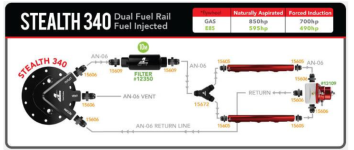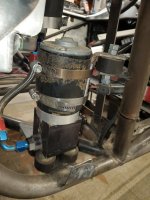well that example above doesnt work for our argument, the pump in this example is "in the tank" so the suction side of this pump is unknown and could be equivalent to a -10 but its unknown. but if it was an effective -8 or -10 then the return and vents are smaller which boost my position.
but it would be nice to know the minimum and then go up if you want. You could never have too much rebar in your slab like putting it 6"OC but at least it would be nice to know the min. who wants to spend or install more than needed, i suppose more is better. i know what you are saying and sure a bigger vent cant hurt but there is no science behind it, im mean i could run -12 fuel lines to my motor cause bigger cant hurt but if a -8 works and calculates out, then i would like to run -8--no need for bigger
I do think it works as an example of vent = outlet size.
I am not saying I have bothered to calculate the exact vent size for each situation, but following the recommendation pretty much guarantees no issues and is easy to do While going with a tiny vent has been demonstrated to cause trouble. So why not just take the easy route and use a big vent - thats What I do and what works for me and nearly every racer. You can use a pin hole and if it works for you .... cool ...Its just air...
Regarding the feed line discussion actually you are incorrect. You can use too big an outlet and it will cause problems. That may not be completely true on the pre - pump gravity feed if the system is designed correctly but read below and see why that can be a problems too - here is why "science stuff"
1. Pressure and volume have a direct relationship - You may not be able to maintain the correct pressure in a bigger volume situation like a huge fuel line - as the pump likely will not be able to fill that volume at that pressure - every pump chart assumes a certain pressure at a certain volume - keeping the line full seems like an easy chore - if this was a Hydraulic system - but fuel systems are Not Hydraulic systems and using a regulator is not an exact "bleed" so its a worst case scenario
2. If you manage to fill the big pipe - you need a regulator and return to bleed off all the fuel you will be wasting trying to keep the pressure up on such a big pipe - that means heating the fuel aerating and and causing more fumes for your tiny vent to exhaust - its just not practical
3. You will likely starve the engine on hard acceleration - thats due to the "weight/Mass" of the fuel - that will actually work against the pressure - this is VERY common on drag cars. The hard acceleration actually pushes against the pump and cars loser pressure. The fix is always to go with a smaller.
You can learn about arteries and blood pressure this way as well and why you pass out from high G's ( and why you have "check valves" in your circulatory system (that how we learn how to engineer thinmgs - we mnostly learn from nature as yoiu know ...)
This also happens with poorly designed wet sumps and remote filters and coolers mostly on cornering - a dry sump is not just for the oil and in the pan but the oil in lines as well - that is a much better closed system with check valves
That science I actually understabd



